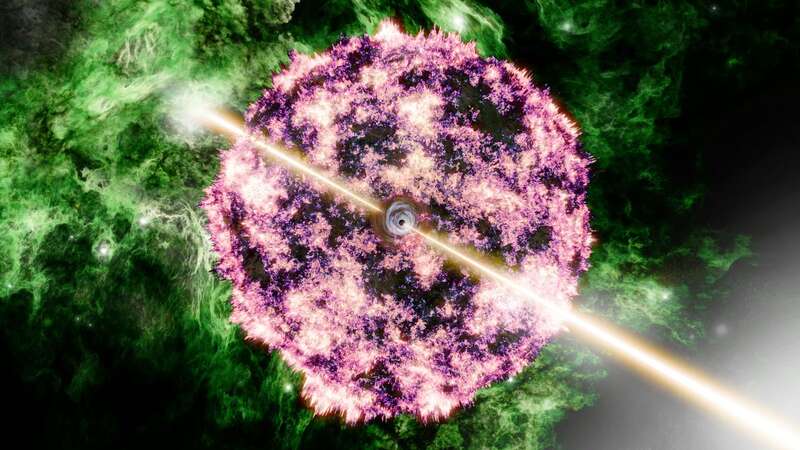

The brightest gamma-ray burst ever recorded was caused by the collapse and explosion of a massive star, astronomers have discovered.
Dubbed the B.O.A.T. ('brightest of all time') a team of astrophysicists observed an historic gamma-ray burst (GRB) in October 2022 which occurred 2.4 billion light years away from Earth. Mystery shrouded what caused this phenomenon, which scientists say only happens once in every 10,000 years.
But now, researchers in the US have confirmed that a star's collapse and subsequent explosion also known as a supernova is what lies behind the awe-inducing GRB. A team from Northwestern University used NASA's James Webb Space Telescope (JWST) to observe the GRB, which was so bright that it saturated most of the world's gamma-ray detectors in the few hundred seconds it lasted.
The astronomers focused on what happened in the months after the GRB instead of at the time, as any images worth studying were too bright. Dr Peter Blanchard, who led the study, explained: "The GRB was so bright that it obscured any potential supernova signature in the first months after the burst. The so-called afterglow of the GRB was like the headlights of a car coming straight at you, preventing you from seeing the car itself. So, we had to wait for it to fade significantly to give us a chance of seeing the supernova."
Once some time had passed, the team observed the GRB's infrared wavelengths, which enabled them to detect elements like calcium and oxygen, which are signatures of a supernova. What surprised the team though was that the supernova was not exceptionally bright unlike the GRB it accompanied.
 Charming UK village is 'UFO hotspot' with 'NASA scientists showing interest'
Charming UK village is 'UFO hotspot' with 'NASA scientists showing interest'
"It's not any brighter than previous supernovae," Dr Blanchard said. "You might expect that the same collapsing star producing a very energetic and bright GRB would also produce a very energetic and bright supernova. But it turns out that's not the case." However, this does not take away from how bright the GBR was which broke records.
"The event produced some of the highest-energy photons ever recorded by satellites designed to detect gamma rays," Dr Blanchard said. This was an event that Earth only sees once every 10,000 years. We are fortunate to live in a time when we have the technology to detect these bursts happening across the universe.
"It's so exciting to observe such a rare astronomical phenomenon as the B.O.A.T. and work to understand the physics behind this exceptional event." While this study, published in the journal Nature Astronomy, solves the mystery about what caused the GRB it has also created another one.
Scientists previously speculated that heavy elements, such as platinum and gold, might be produced by the collapse of a massive, rapidly spinning star, like the one in this case. However, their extensive search showed no proof of this meaning the origin of the universe's heavy elements continues to be one of astronomy's biggest unanswered questions.
Dr Blanchard explained: "When we confirmed that the GRB was generated by the collapse of a massive star, that gave us the opportunity to test a hypothesis for how some of the heaviest elements in the universe are formed. However, we did not see signatures of these heavy elements, suggesting that extremely energetic GRBs like the B.O.A.T. do not produce these elements.
"That doesn't mean that all GRBs do not produce them, but it's a key piece of information as we continue to try to pin down where the heaviest elements are formed. Future studies will focus on whether the B.O.A.T.'s 'normal' cousins produce these elements."
The researchers are also left unsure about how a 'normal' supernova and a record-breaking GRB were produced by the same collapsed star. However, co-author Dr Tanmoy Laskar, a professor at the University of Utah, said it might be related to the shape and structure of so-called 'relativistic jets'.
He explained: "When rapidly spinning, massive stars collapse into black holes, they produce jets of material that launch at rates close to the speed of light. If these jets are narrow, they produce a more focused and brighter beam of light. It's like focusing a flashlight's beam into a narrow column, as opposed to a broad beam that washes across a whole wall.
"In fact, this was one of the narrowest jets seen for a GRB so far, which gives us a hint as to why the afterglow appeared as bright as it did."